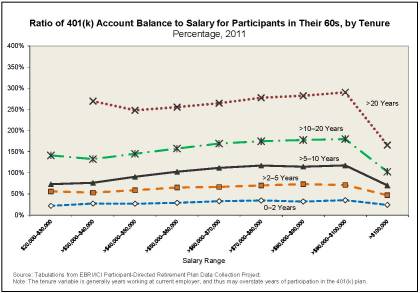 Consider that average participation rates in excess of 70 percent are commonly reported in industry surveys, and that’s for plans that don’t take advantage of automatic enrollment. Moreover, previous EBRI research has pointed out that merely having access to a defined contribution plan at work can have a significant positive impact on one’s retirement readiness rating, simply because it greatly enhances the likelihood that those individuals WILL participate (1).
Consider that average participation rates in excess of 70 percent are commonly reported in industry surveys, and that’s for plans that don’t take advantage of automatic enrollment. Moreover, previous EBRI research has pointed out that merely having access to a defined contribution plan at work can have a significant positive impact on one’s retirement readiness rating, simply because it greatly enhances the likelihood that those individuals WILL participate (1).Those who say that you can only “lead a horse to water” might well expect that a horse will drink when it’s thirsty, or when it needs water—but equine experts will tell you that many horses refuse to drink when they need to most, especially in times of competition, illness, travelling or stress. So, while you may not be able to make them drink, it’s generally important for their health and well-being to find ways to encourage them to do so—adding a little salt in their diet, for instance, or putting an apple in their water bucket.
Similarly, all workers don’t have access to retirement plans at work, and those who do don’t always take full advantage of it—with some saving below the employer match levels of their plan, many older workers failing to take advantage of catch-up contributions, and a number of automatically enrolled workers leaving those relatively low initial default contribution rates in place.
There are, however, steps employers can take to help: Prior EBRI research has documented the profound influence of plan design variables, as well as employee behavior in auto-enrollment 401(k) plans (2). Not only the impact that automatic enrollment can have on retirement readiness, but what setting that initial default rate at 6 percent, rather than the “traditional” 3 percent (now codified in the Pension Protection Act of 2006) could mean in terms of improving retirement readiness “success.(3)”
For example, using actual plan-specific default contribution rates, and assuming an automatic annual deferral escalation of 1 percent of compensation; that employees opted out of auto-escalation at the self-reported rates from the 2007 Retirement Confidence Survey; and that they “started over” at the plan’s default rate when they changed jobs and began participation in a new plan; along with the assumption that the plan imposed a 15 percent cap on employee contributions, the EBRI analysis found that more than a quarter (25.6 percent) of those in the lowest-income quartile who had previously NOT been successful (under the actual default contribution rates) would then be successful (4) as a result of the change in deferral percentage.
As benefit plan professionals know, and as EBRI research has quantified, plan design can be effective at doing more than just leading workers to the opportunity to save for retirement—it can help them make decisions that improve their chances of success.
Nevin E. Adams, JD
[1] See “’Retirement Income Adequacy for Today’s Workers: How Certain, How Much Will It Cost, and How Does Eligibility for Participation in a Defined Contribution Plan Help?” online here.
[2] See “The Impact of Automatic Enrollment in 401(k) Plans on Future Retirement Accumulations: A Simulation Study Based on Plan Design Modifications of Large Plan Sponsors,” online here.
[3] See “Increasing Default Deferral Rates in Automatic Enrollment 401(k) Plans: The Impact on Retirement Savings Success in Plans With Automatic Escalation,” online here.
[4] In this case, success equals a real replacement rate of 80 percent or more when combined with Social Security.


